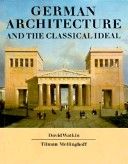German Classicism is a powerful architectural force that is only now being fully studied. As this extensively illustrated book shows, palaces, private houses, public buildings, and urban planning all received patronage on a scale that could not be paralleled in other countries. Of the host of architects whose genius was given such superb opportunities in the years 1740 to 1840, only Karl Freidrich Schinkel's name has become widely known; yet this book points out, all over Germany rulers were dramatically transforming their capitals, and the achievements of Weinbrenner at Karlsruhe, Moller at Darmstadt, or Klenze at Munich are by any standards astonishing.The first part of the book is by David Watkin, a leading British authority on the Classical Revival. He provides a historical account that sets German Neoclassicism in its regional and political context, and notes the impact of France and England and the Franco-Prussian style before Schinkel. He discusses Schinkel's own work, that of Leo von Klenze, and Neoclassicism in North and South Germany.The book's second part consists of an index of buildings prepared by Tilman Mellinghoff. Here every important Neoclassical building (both existing and destroyed) is listed and described under its location. The index is an invaluable source of information available nowhere else in English.David Watkin is a Fellow of Peterhouse and a University Lecturer in History of Art at Cambridge University. Tilman Mellinghoff is an Assistant Lecturer at the Universities of Cologne and Bonn.
- ISBN10 0262231255
- ISBN13 9780262231251
- Publish Date 9 June 1987
- Publish Status Out of Print
- Out of Print 18 January 2011
- Publish Country US
- Publisher MIT Press Ltd
- Imprint MIT Press
- Edition Mit Press ed.
- Format Hardcover
- Pages 300
- Language English
